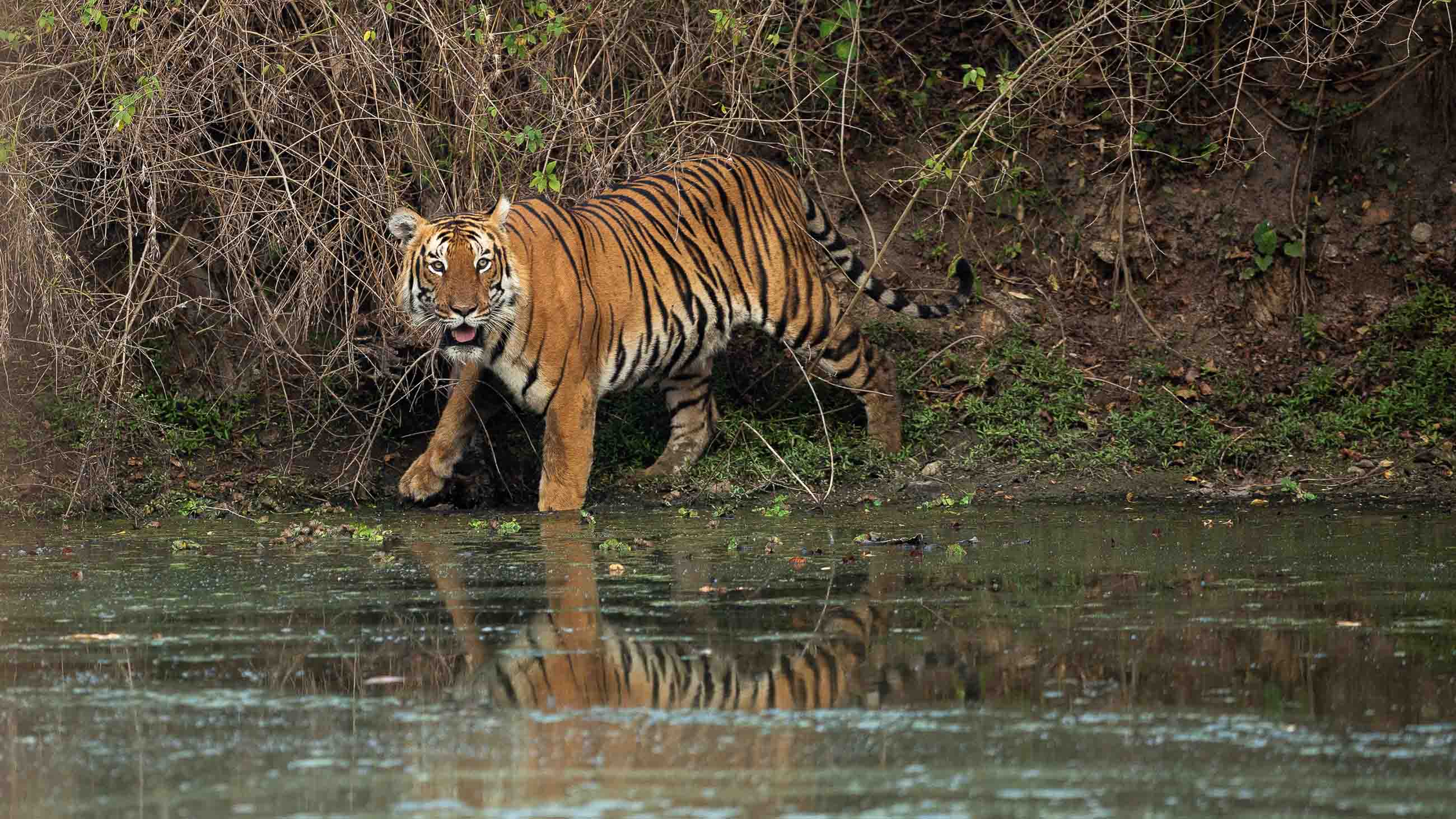India’s ‘Man-Eating’ Tigers Entangled in a Blame Game
on a late August afternoon in 2019, a farmer named Shivamadaiah walked with his cattle near Bandipur National Park. The roughly 330-square-mile forested reserve, known for its resident wildlife, lies serenely in the foothills of the Western Ghats in India’s southwest state of Karnataka.
That night, Shivamadaiah didn’t return home. When a few people went to find him the next day, they initially came upon his ripped slipper. The group walked further, recalls his son, Madhusudhan, who like his father and many Indians, goes by one name. After half a mile, they found Shivamadaiah’s half-eaten body lying under a large banyan tree. A tiger had initially aimed for the cows, says Madhusudhan. But then it pounced on their owner instead.
The tiger had taken to roaming outside the forest in order to avoid competing with other tigers for food, says Madhusudhan. “It started getting close to human habitats,” he says; it preyed upon cattle. After attacking Shivamadaiah, the big cat went on to kill another local resident.
Madhusudhan is now a forest watcher in the reserve — a job offered to him as compensation for his father’s killing. The two tragic deaths troubled the local people, he says, so they lobbied for the tiger’s removal from the park. The forest authorities responded, tranquilizing the cat and relocating it to a zoo.
India is home to more than 70 percent of the world’s tigers. They are the country’s national animal, placed under Schedule I of the Wildlife Protection Act, which confers the highest degree of protection for wild animals on the subcontinent. Tigers occupy a significant place in Hindu mythology, and the big cats are symbols of magnificence and valor.
But tiger conservation has not always been a top priority. Widespread hunting, along with habitat destruction, reduced their numbers from an estimated 40,000 in the 1950s to a mere 1,827 in the early 1970s. That decline prompted Parliament to pass the Wildlife Protection Act in 1972. The following year, the Indian government launched Project Tiger, which created nine reserves. India now has more than 50 reserves and nearly 3,000 tigers, according to the latest census.
As the carnivores have rebounded and reclaimed some of their historic range, humans have pursued development in areas not far from tiger habitat. Likely as a result, from 2010 through 2019, tigers killed 383 humans and valuable livestock. People are starting to lose their tolerance for the big cats, some wildlife biologists say. In 2019, villagers in the state of Uttar Pradesh beat a tigress to death after she attacked a local resident.
But the majority of tigers do not attack humans, and according to some experts, it is important to identify and remove those that do present a threat, in order to minimize human suffering and maintain popular support for tiger conservation. To this end, the Indian government developed guidelines for classifying “man-eating” tigers (the official term has since changed). But classification of individual tigers is often fraught, as are decisions about whether to kill or tranquilize and relocate these large carnivores.
Although the exact number of human-eating tigers remains unknown, wildlife experts say that tigers rarely treat humans as prey, stalking and consuming them only under certain conditions. Bengal tigers live up to 16 years in the wild on average, according to the World Wide Fund for Nature-India, and as they age, they lose strength in their teeth and claws. “All these things will make the tiger slightly weaker than its younger cousins,” says N.S. Manoharan, a wildlife veterinarian located in the southern state of Tamil Nadu.
These aging or injured tigers may move towards newer spaces, outside of the forest boundaries, in order to avoid younger tigers that dominate the area. This raises the likelihood that they will encounter humans and livestock — easy prey, even for a debilitated tiger. The problem is exacerbated when humans develop land that is adjacent to traditional tiger habitats.
This is a familiar pattern, exhibited in other animals. For example, while bear attacks in general are rare, bears may prey on humans when they’re unable to find other food in the wild, for reasons such as being older or having damaged teeth, says Chris Servheen, a now-retired associate professor of wildlife conservation at the University of Montana. And some crocodiles may attack humans when they lose access to the fish that comprise the bulk of their diet, according to Brandon Sideleau, a wildlife biologist and co-creator of CrocBITE, a website that maintains records of crocodile attacks on humans globally. Fatal attacks are more likely to occur when there has been human encroachment on the reptiles’ habitats. In parts of Indonesia, tin mining has led to declines in fish, says Sideleau, so crocodiles are “pretty much going after whatever food they can get, which are people, dogs, cattle.”
To address the problem, India’s tiger conservation body, the National Tiger Conservation Authority, established a set of guidelines aimed at preventing tigers from attacking humans. These guidelines included creating buffer zones around tiger habitats and monitoring the movement of tigers that wander near human settlements. The guidelines also described conditions under which a tiger can be declared a “man-eater” and outlined steps for dealing with such problematic animals.
Those guidelines specified two distinct categories for tigers that kill humans: “man-killing” and “man-eating.” The former included big cats that had killed a human as a direct result of being startled during sleep or intruded upon while sheltering cubs, for example. These killings were considered accidental. “Man-eating,” on the other hand, included tigers that had stalked and attacked humans then eaten the body. These latter carnivores, according to the guidelines, needed to be promptly removed from the wild. Authorized personnel were permitted to kill the aberrant tiger in certain cases, though updated guidelines stress this “should be the last option” if efforts to capture and tranquilize it fail.
Currently, to determine whether a tiger should be considered dangerous to humans, forest officials are advised to inspect the cameras that hang from trees and posts in all of India’s tiger reserves. These camera traps, as they are known, record tiger movement and allow officials to identify individual cats by their unique stripe pattern. Officials may also order molecular analysis, testing a suspected tiger’s fecal matter to check for the presence of human DNA.
Over the past few years, wildlife activists have accused state governments of killing tigers in the absence of such evidence. In 2018, the Maharashtra Forest Department issued a shoot-at-sight order for a tigress named Avni, a mother of two cubs, that had allegedly killed 13 villagers. Wildlife activist Jerryl Banait maintained that there was no evidence to confirm that Avni caused all 13 deaths — a view echoed by others.
India’s Supreme Court said that efforts must be made to tranquilize the animal before killing it. Within two months of that ruling, Avni was killed not by the hunter hired by the state, but by the hunter’s son. The tigress’s death sparked widespread outrage across the country.
After Avni’s death, the National Tiger Conservation Authority prepared a new report, which stated that problematic animals should be referred to as “dangerous to human life” and not “man-eaters.” The government has since followed suit, and no longer appears to use the term in official documents.
Not all experts have embraced the new wording. “Even a snake is dangerous — a venomous snake is dangerous to human lives,” says Yadvendradev Jhala, dean of the Wildlife Institute of India, a research institution within the Ministry of Environment, Forest, and Climate Change. The new term is too broad, says Jhala. (He similarly characterized “man-eater” as “loose terminology.”) A better term would clearly convey that a tiger has a proven track record of human attacks, he says. But new guidelines aside, Indian officials and wildlife experts continue to use the term man-eater.
Jhala also noted that the current guidelines are stringent and difficult to implement in the field. “You need to have camera trap evidence or visual sighting, and then recognize the animal, either from its stripes or from its DNA,” he says. “And that takes a long time to do. Meanwhile, that tiger, if it is a proclaimed man-eater, or has a propensity to kill humans and eat them, is going to continue on the rampage.”
Once a tiger has been determined to pose a threat to humans, it’s important to promptly kill it so that it doesn’t take more human lives, says Ullas Karanth, a tiger expert and former director of the Center for Wildlife Studies in India, who notes that such cases are rare. Unlike most activists, and even some of his own colleagues, Karanth says that shooting is generally the most effective solution because of the challenges inherent in tranquilizing and then relocating a wild tiger. To tranquilize a tiger, the animal needs to be within close range and away from thick vegetation. Because those attempts are likely to fail, he says, the tiger can continue to kill more people in the meantime. Even when big cats are captured and relocated to zoos, he adds, they often don’t adapt well to captivity.
“Once it gets to the stage of killing several human beings, the entire public turns hostile to wildlife conservation. So, for saving this one animal, you’re putting the life of all tigers at risk in the region,” says Karanth. He also notes that tigers breed quickly so killing one human-eater does not threaten their overall population.
City-dwellers, Karanth adds, have no idea what it’s like to live within range of a human-eating carnivore, and he says they are often the ones to pressure the government not to kill persistent predators. Yet nearly 250 million people in India live in or near forests. This past October, the capture of a tiger known as T-23 sparked conflicts between forest authorities and forest area residents. The big cat that prowled lush green forests in Tamil Nadu reportedly killed four people and more than 20 cattle. Local residents urged state wildlife officials to capture the tiger as quickly as possible, says Thangavel, a local resident who witnessed the second mauled body. The image, he adds, haunted him for nearly a week.
After repeated attempts to capture the animal alive, Shekhar Kumar Niraj, the state’s chief wildlife warden, issued a hunting order. A squad of forest officials, veterinarians, and other experts set out on a vigorous search to hunt the tiger. The mission, which Niraj led, went on for two weeks, and during this time, local people were prohibited from entering the areas around the forest. This was a blow to their livelihoods, says Thangavel, as the villagers could not bring their livestock to graze nearby.
Although the deaths of three people were ascribed to the tiger, T-23 “was not a man-eater,” says Niraj. Nevertheless, under Indian law, chief wildlife wardens can use their discretion to issue hunting orders on a case-by-case basis. In this case, Niraj determined that T-23 posed a threat because the region was densely populated with humans. The tiger had also become weak and had some problems with its teeth. “It had lost its hunting capacity,” he says.
To ensure the long-term survival of big cats, it might be necessary to do more than simply classify and remove human-eaters, says wildlife conservationist Latika Nath. In India today, hundreds of villages overlap with tiger habitat. Going forward, it may be necessary to create more spaces that are truly free of human presence. Dual use spaces will continue to exist, though, and it’s important for everyone to be on the same page when it comes to land management, she says.
Mathen “Rajeev” Mathew, a wildlife consultant with India’s Center for Innovations in Public Systems, shared an additional view, one that has begun to emerge among some tiger conservationists: “We have to come to a point where we realize that it’s only so many animals that we can have,” he says. “Anything over it should be removed.”
As the issue is debated and weighed, many Indians, forest dwellers included, continue to hold tigers in high regard. For his part, Madhusudhan has not lost his empathy for the big cats. As a forest watcher, it’s his job to monitor wildlife, and on a couple of occasions, he says, he has safely stood as close as 30 to 60 feet from a tiger.
He adds: “They are just animals.”
Niranjana Rajalakshmi is a science journalist and a former veterinary physician, currently based in New York City. She covers health, climate crisis, biodiversity, and conservation.












Comments are automatically closed one year after article publication. Archived comments are below.
India and Nepal’s tiger conservation programs have been successful. The problem is that growth of the human population outside of the reserves and growth of the tiger population inside the reserves increases the pressure on the buffer regions – which were never designed to handle these numbers. When an animal start preying on neighbouring human populations then it has to be destroyed – unless you are placing a value on it that is larger than that that of a person. T1 (Avni) fell under this description. The conflicts between humans and big cats is on the rise, not only in India – in the end humans will win and the cats will be gone – this is a tragedy that should/must be avoided however this can only be done by enforcing the separation between species. If the reserves cannot grow then the big cat populations have to be controlled more effectively. Curiously it costs about 7 lakh to rehabilitate a leopard and 4 to destroy it. In Utrakhand for example leopards are the main source of negative big cat/human interaction and the most cost effective solution, from the perspective of saving human lives, is obvious – however to protect both humans and leopards is a far more difficult problem than protecting both tigers and humans. Note that leopards are essential in parts of rural India as they control populations of boars etc that would destroy local agriculture if populations were allowed to grow unchecked. A difficult problem – I hope India is up to solving it.
I sense parallels in this situation with reviving wolf populations in the American West parks such as Yellowstone. Generally, ranchers (excessively) blame livestock loss on wolves and want them to be hunted/removed.